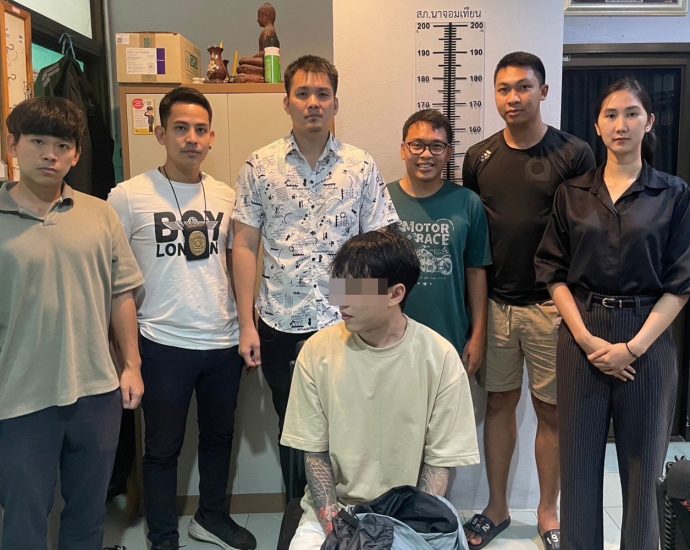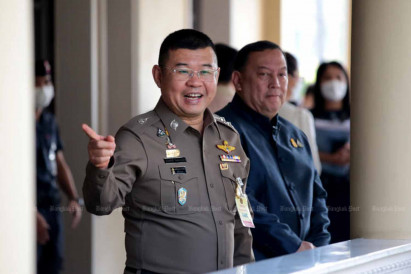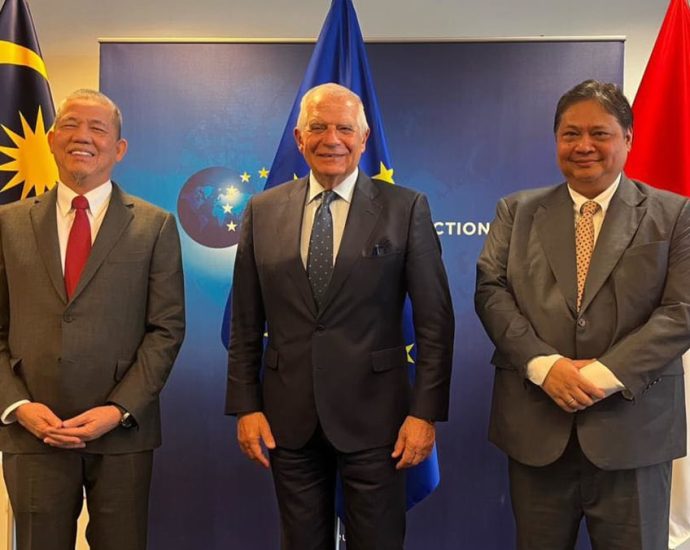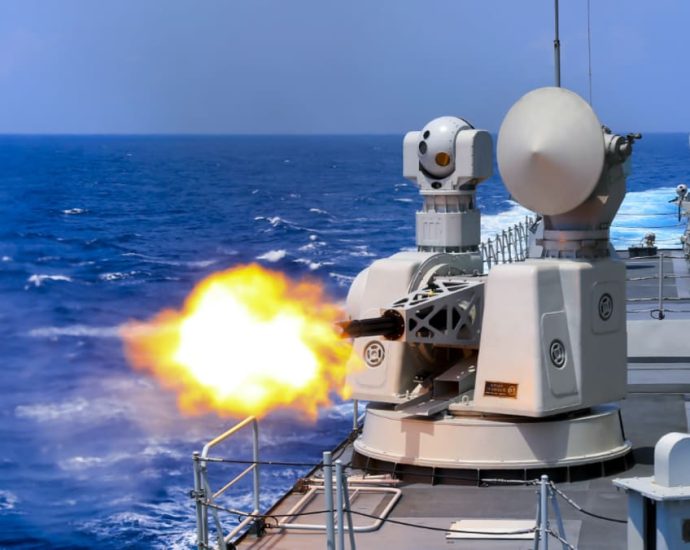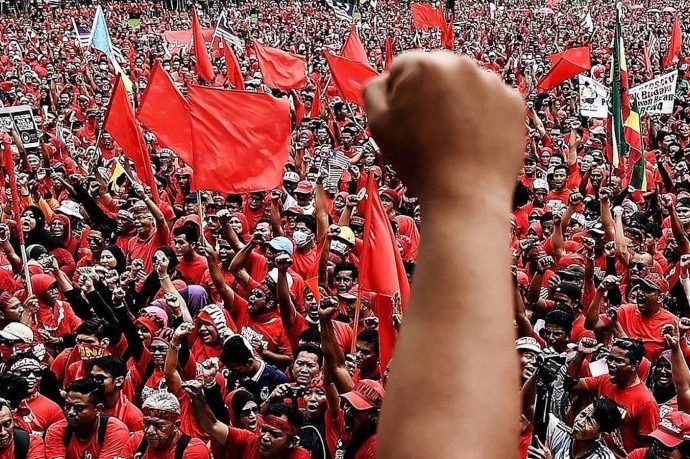Nepali sherpa saves Malaysian climber in rare Everest ‘death zone’ rescue
Gelje said he convinced his Chinese client to give up his summit attempt and descend the mountain, saying it was important for him to rescue the climber. “Saving one life is more important than praying at the monastery,” said Gelje, a devout Buddhist. Tashi Lakhpa Sherpa of the Seven SummitContinue Reading
Korean drug suspect arrested in Chon Buri
Police in Seoul sought Thai authorities’ help to track down dealer

CHON BURI: A South Korean man wanted in his home country for drug offences has been arrested in Sattahip district of this tourist province, police said on Wednesday.
Immigration police apprehended the man, identified only as Kim, 26, at a luxury housing estate in tambon Na Jomtien, said Pol Lt Col Pakphumpipat Sajjaphan, commissioner of the Immigration Bureau (IB).
Between June last year and March this year, South Korean drug suppression police carried out crackdowns on illicit drugs at entertainment venues in the Gangnam and Itaewon districts of Seoul and arrested 70 people, including dealers and users, said the IB chief. Various kinds of drugs were seized along with cash equivalent to 17 million baht.
South Korean investigators found that one of the dealers they were targeting, Mr Kim, had fled to Thailand. Drug suppression authorities in Seoul obtained an Interpol Red Notice for his arrest and sought cooperation from Thailand to help find him, said Pol Lt col Pakphumpipat.
Immigration police found that Mr Kim had entered Thailand on a tourist visa on July 13 last year and was staying a luxury housing estate in tambon Na Jomtien.
The investigators tracked him there and he was handed over to Na Jomtien police station for legal proceedings.
Pol Lt Gen Pakphumpipat said the investigation showed that Mr Kim used the Telegram app to communicate with his customers, and delivered drugs at entertainment venues. The suspect had also smuggled illicit drugs from Thailand to South Korea, he said.

Pol Lt Col Pakphumpipat Sajjaphan, commissioner of the Immigration Bureau, announces the arrest of a South Korean drug suspect at a media briefing in Chon Buri on Wednesday. (Photo: Chaiyot Pupattanapong)
CPIB investigating marine engineering firm Seatrium over alleged corruption offences in Brazil
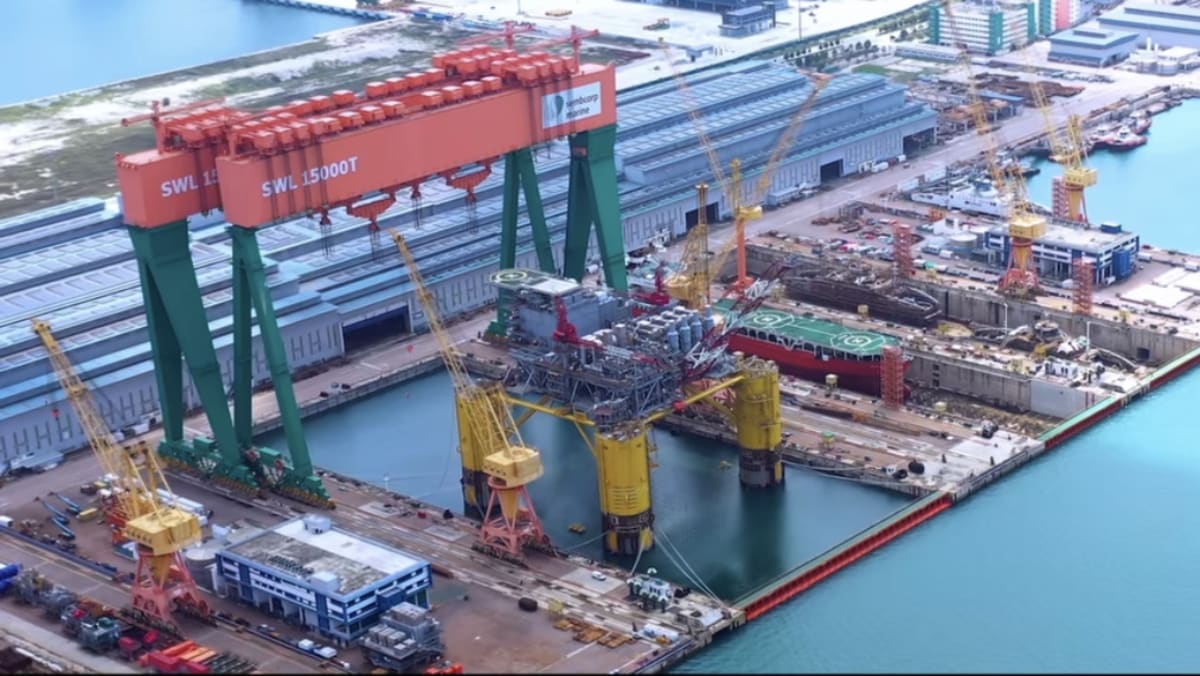
In January, six former senior management staff members of KOM were given stern warnings by CPIB over the Petrobras case.
The warnings were in lieu of prosecution for offences punishable under the Prevention of Corruption Act.
The offences relate to bribe payments to Petrobras officials, pertaining to rigs-building contracts which Petrobras or its related companies had awarded to KOM.
The six former employees were not prosecuted over the multimillion-dollar bribery case due to insufficient evidence to establish their guilt beyond a reasonable doubt, said Minister in the Prime Minister’s Office Indranee Rajah in Parliament on Feb 6.
“Simply put, there is a lack of sufficient evidence, either documentary or through witnesses, which would establish any criminal charge beyond a reasonable doubt against a specific individual,” she said then.
In its statement on Wednesday, CPIB said it “investigates without fear” and would not hesitate to take action against any parties involved in corrupt activities.
Highway bribery long entrenched, police chief admits

National police chief Pol Gen Damrongsak Kittiprapas has admitted the practice of highway police demanding and taking bribes from truck operators has long been in existence.
It had “exploded” on public awareness recently only after details were posted on social media, Pol Gen Damrongsak said on Wednesday.
He was speaking after Pol Lt Gen Jirabhop Bhuridej, the Central Investigation Bureau chief, signed an order reassigning Highway Police commander Pol Maj Gen Ekarat Limsangkas to the CIB operations centre.
The move followed reports on social media that drivers of overloaded lorries were not being arrested at highway weighbridges if they had one of several stickers on their vehicles showing bribes had been paid.
Pol Maj Gen Jaroonkiat Pankaew, commander of the Anti-Corruption Division, was assigned to concurrently act as commander of the Highway Police Division.
Wiroj Lakkhanaadisorn, a Move Forward Party list MP-elect, last week posted on social media that he was compiling evidence about the racket. He claimed overloaded trucks with special stickers were not being detained or the drivers arrested at weighbridges.
Pol Gen Damrongsak said, “Bribe-paid stickers have long been in use, despite suppression efforts. The matter has become explosive because it has been brought to the attention of society. All agencies concerned are now rushing to try and find out how many of them are currently being used.”
He said he had instructed the Office of the Inspector-General and the CIB to jointly investigate the matter.
Pol Gen Damrongsak said the transfer of the Highway Police Division commander was to ensure the investigation could be carried out with transparency. The investigation would cover both the bribe givers, who might be the transport operators, and those who received the payments, who might be state officials or their middle-men.
State officials found involved would face both criminal and disciplinary action, he said.
Police found guilty of involvement would face consequences, he said, adding that this year, to date, about 79 police officers had been sacked after being found involved in dishonest activities.
The national police chief said he had earlier already issued instructions for police to take tough action against overloaded lorries. Now that the matter had become big news, he would issue an official order for them to be more strict in enforcing legal weight limits.
A special committee would be set up to keep watch for those who turn a blind eye, or are lax in enforcing the traffic law, he said.
“The story about bribe-paid stickers is old, but has been posted on social media. Some posters may be ill intentioned toward police. I would like people to understand that police work hard from every aspect,” Pol Gen Damrongsak said.
Chinaâs C919 takes off with US sanctions on the horizon
China’s Comac C919 passenger jet made its first commercial flight from Shanghai to Beijing on May 28, completing a state-backed development, manufacturing and qualification process dating back to 2007 that now promises to shake up the global civil aviation business.
China Eastern Airlines, the local airline that flew the plane’s first flight, took delivery of the C919 last December. The short- to medium-range plane is expected to go head to head soon with the Airbus A320 and Boeing 737 for local sales and global markets.
One passenger reputedly told China’s Communist Party-run Global Times: “I am so excited to be one of the first passengers to fly on the C919. I am so proud that China now has such advanced aircraft manufacturing industry.”
The state-run Beijing Daily triumphantly declared: “After generations of endeavor, we finally broke the West’s aviation monopoly and rid ourselves of the humiliation of ‘800 million shirts for one Boeing.’”
Critics were quick to note that the C919’s engine, avionics and other key components are procured from US and European suppliers. The Wall Street Journal, for one, reported the C919 “faces a steep path to success.”
But the fact remains that Comac’s assembling of a modern passenger aircraft marks a major Chinese accomplishment.
To put things in one comparative perspective, Japan’s Mitsubishi Regional Jet, also announced in 2007, has suffered numerous humiliating setbacks and was embarrassingly renamed Mitsubishi SpaceJet before it was altogether canceled in February of this year.
A comparison with Boeing is also instructive. Airbus took a slight lead over Boeing in the China market a decade ago, but the gap abruptly widened in 2019 after Boeing 737 MAX aircraft crashed in Indonesia and Ethiopia due to defective flight control software.
In 2022, Airbus sent more than 100 aircraft in China while Boeing delivered fewer than 10. US-China trade tensions also appear to have contributed to Boeing’s poor performance in China, where Airbus has no such problem.
Airbus now accounts for more than 50% of commercial aircraft in service in China and appears likely to maintain or increase its market share with the establishment of a second A320 assembly line at its factory in Tianjin, China.
The agreement setting this in motion was signed during French President Emmanuel Macron’s visit to China in early April. Airbus CEO Guillaume Faury was one of about 60 French business executives who accompanied Macron.

Although the 737 MAX is now back in service and China Southern Airlines is reportedly planning to order 103 new aircraft from Boeing (and 111 from Airbus), data from Aviation Week shows orders for 697 C919 aircraft, most of them from Chinese airlines and leasing companies.
If current trends hold, it seems that Comac could – in fact, is likely to – soon overtake Boeing to become the second-largest commercial aircraft supplier in China.
This, of course, will depend on whether or not Comac can assemble hundreds of aircraft in time to meet delivery schedules while avoiding the quality problems that have plagued Boeing. In April, Boeing revealed that deliveries of a number of 737 MAX aircraft had been delayed due to quality problems at US subcontractor Spirit AeroSystems.
The Chinese government wants the C919 to have 10% of China’s domestic commercial aircraft market by 2025. Five years from now, Comac wants to be producing 150 C919 aircraft per year. China Eastern will reportedly take delivery of its second C919 in June.
However, there are concerns that the US Department of Commerce may try to ground the C919 by imposing new export restrictions on its US suppliers.
In January 2021, then-President Donald Trump had the Department of Defense add Comac to its list of companies owned or controlled by the Chinese military. As a result, US investments in Comac were banned.
In April of this year, US Senators Marco Rubio and Rick Scott of Florida sent a letter to Under Secretary of Commerce for Industry and Security Alan Estevez complaining about the department’s failure to add Comac to its Military End User (MEU) list.
The senators wrote that:
“COMAC also works closely with Western aerospace companies, including firms that produce jet engines and many other components used in commercial and military aircraft. Given the CCP’s [Chinese Communist Party’s] commitment to acquire dual-use aerospace technologies through trade as well as forced joint venture and partnerships, these firms, and U.S. national security by extension, are at risk.”
For reference, Comac is owned by the State-Owned Assets Supervision and Administration Commission (SASAC) of China’s State Council (the chief administrative organ of the People’s Republic), state investment company Shanghai Guo Sheng, Aviation Industry Corporation of China (AVIC, which is on the MEU list), Aluminum Corporation of China, China Baowu Steel, Sinochem, China Electronics Technology and other corporations.
Until now, it is not clear if the US Commerce Department will heed Rubio and Scott’s plaintive call. If it does, several US companies could be affected, including GE, Honeywell, Rockwell Collins and Parker Aerospace.
The Global Times commented that “The maiden commercial flight by China’s first domestically-manufactured large passenger aircraft… ushers in a new era for the cooperation between Chinese manufacturers and foreign companies.”
If that optimistic view is squelched, an aggressively nationalist response would be all but certain, to the detriment of US aerospace companies and the advantage of their Chinese competitors and Airbus. Mass production of the C919 would be delayed but not abandoned.

As Wang Yanan, chief editor of China’s Aerospace Knowledge magazine, puts it: “We must have our own manufacturing capabilities for regional aircraft and large commercial airliners.”
Some 200 Chinese subcontractors supply the C919’s fuselage, wings, forged parts and other basic components and materials. Avionics and engines are likely to follow, with or without US sanctions.
Aero Engine Corporation of China is already developing an alternative to the LEAP jet engine manufactured by CFM International, a joint venture between GE Aviation of the US and Safran Aircraft Engines of France that powers the C919.
The question is, does the US want to participate in or decouple from the world’s most promising civil aviation market?
Follow this writer on Twitter: @ScottFo83517667
Indonesia, Malaysia criticise EU for ‘discriminatory and punitive’ actions against palm oil sector
Earlier on Wednesday, Mr Fadillah said on Facebook: “We have suggested that (the EU) hold discussions through either a task force or a dialogue involving producing countries, industry players, representatives of non-governmental organisations (NGOs) and smallholders so that there will be clarity in terms of established guidelines and so thatContinue Reading
Thai PM-elect Pita could be disqualified due to alleged shareholding in media firm: Caretaker DPM
According to Bangkok Post, Mr Wissanu said a complaint may also target Mr Pita’s approval of Move Forward Party memberships. “In that case, there would have to be a new nationwide general election,” he was quoted as saying. Bangkok Post also quoted Mr Wissanu as saying that the Election CommissionContinue Reading
Young clay modeller taken under national artist’s wing

SURAT THANI: A 10-year-old who builds pictures with modelling clay and sells them to help pay for his mother’s cancer treatment has caught the eye of a national artist, who has accepted him as his student.
He has also been recognised by provincial authorities.
Surat Thani governor Wichawut Jinto on Wednesday gave Methasit Boonphoei, a fifth grader at Manitanukroh School in Muang district, a certificate honouring his dedication to helping his parents.
The governor said Methasit had mastered clay modelling, winning awards and raising funds for his family, helping pay for this mother’s treatment for breast cancer, through sales of his artworks.
The youngster, also known as Khao Pan, lives in Kanchanadit district with his 42-year-old father, a latex tapper, and 44-year-old mother. He is an only child.
His mother, Kannika Phutsri, said her son had first shown an interest in Buddhist sculptures when he was only two years old.
During their visits to temples the boy had paid special attention to the Naga sculptures, and began building models of them at home from toy clay, she said.
On May 2 this year they had visited the White Temple in Chiang Rai province. Methasit had showed his latest Naga image to national artist Chalermchai Kositpipat, who built the temple, and sought his opinion, Ms Kannika said.
Chalermchai had been impressed, and he had invited the boy to be his student, Ms Kannika said.
The Surat Thani governor said Methasit had worked alone in developing his skill and helping his famliy, bringing high repute to himself, his family, his school and his province.
“Above all he has a good heart and shows gratitude towards his parents, and is a good model for other children and youth in general,” Mr Wichawut said.
The governor also gave a gift of cash to the boy, as moral support, and wished him success in the arts and continued good deeds in the future.
His mother earlier underwent surgery and is still receiving chemotherapy.
China to join Indonesia’s multilateral naval drills despite rising tension
BEIJING: China will send warships to a multilateral naval exercise hosted by Indonesia in June, which has also invited countries such as North Korea, Russia, South Korea and the United States, amid rising tension in the Asia-Pacific region. The drills come as China and the United States ramp up militaryContinue Reading
Mahathir stirring racial mischief in Malaysia
Despite being a notch below 100 years old, Malaysia’s former prime minister Mahathir Mohamad remains active in politics.
Mahathir, a lifetime champion of Malay rights, was in frequent conflict with the Malaysian Islamic Party (PAS) throughout much of his first tenure as prime minister from 1981 to 2003. Against this historical backdrop, the rapprochement between the Islamist PAS and Mahathir in May 2023 is perhaps surprising.
PAS President Hadi Awang signed up to the “Malay Proclamation“, a 12-point document written by Mahathir that calls for Malay unity to “restore the political power of Malays.” Malays — who form Malaysia’s dominant ethnic group — together with other Bumiputera constitute two-thirds of Malaysian citizens.
But the proclamation claimed that Malays have “lost” political control — presumably under current Prime Minister Anwar Ibrahim — with calls to put aside political differences to “revive” and “save” the Malay race.
Mahathir ostensibly has a point. He contends that Malays are split into three political camps. In Malaysia’s November 2022 general election, the Malay vote was split among three rival coalitions — Perikatan Nasional (PN), Barisan Nasional (BN) and Pakatan Harapan (PH), in descending order. The Anwar-led unity government is a coalition of PH, BN and East Malaysian parties.
Since Malaysia’s independence in 1957, racial politics has been at the forefront of political discourse. Politicians and political parties often appeal to one specific racial group. For Mahathir, “Malay unity” is a dream and political slogan to galvanize support — never mind that such goals are not feasible or to be desired in the first place.
The paradox of Malay unity can be seen in the coming together of Hadi Awang and Mahathir. At the 1999 general election, PAS captured Terengganu from the United Malays National Organization (UMNO).
Then prime minister and UMNO president, Mahathir terminated petroleum royalty payments to PAS-led Terengganu for resources extracted within the state, even though its economic development is among the lowest in Malaysia. Hadi Awang served as the then-Terengganu chief minister and relations with Mahathir soured.
Apart from being a pure power play, the conflict stemmed from competing political loyalties among Malays. PAS’ political Islam ideology — where Islam is the source of inspiration for social behaviors and politics — conflicted with UMNO’s ethnic focus on Malay nationalism.
PAS also stressed spiritual advancement, while UMNO is perceived as oriented towards economic and material goals. Since the Malaysian constitution legally obliges Malays to subscribe to the Islamic faith, PAS and UMNO are essentially competing for the same pool of voters in the electorate.

Despite multiple attempts by UMNO and PAS to collaborate since the 1970s, political coalitions between the two have typically failed spectacularly, with Muafakat Nasional being the latest casualty.
Despite Anwar serving as prime minister, PH only received an estimated 13% of Malay votes in the 2022 general election. The opposition PN coalition comprised of PAS and the Malaysian Indigenous United Party are both Malay-based ethnic parties. Against this backdrop, Anwar’s political opponents conveniently accuse his administration of neglecting Malay interests, from housing ownership to Islamic affairs.
For a multiracial country like Malaysia where non-Malays form a third of the total population, attempts to galvanize one racial group may be detrimental to the country’s social fabric. Calls for “Malay unity” are exclusionary as the concept elevates Malay rights while neglecting the needs and interests of non-Malays.
Such narratives could lead to a zero-sum game where Malaysians perceive each other as competitors rather than partners. Malaysia’s multiracial society would be polarised along racial lines — as it already is to a worrying degree — which increases the likelihood of social unrest.
A more inclusive approach to politics is required. Instead of focusing on race, an issue-based approach to politics would address pressing societal challenges and promote the common good.
Malaysia is faced with grave development challenges, spanning from escaping middle-income stagnation to dealing with youth underemployment and recurrent severe flooding amid climate change — problems that transcend racial boundaries. A race-based approach to politics cannot solve any of the above problems.
Focusing political discourse on issues that affect all Malaysians would encourage greater social cohesion and reduce the risk of spiraling political polarization.
But it is important to acknowledge that the Malaysian government is faced with pressing challenges to obtain sufficient support from ethnic Malays. Six out of 13 Malaysian states are scheduled to hold state elections in July 2023, which will provide a good indicator on whether Malays are broadly supportive of Anwar’s administration.
Malays and Bumiputera are mostly supportive of continued affirmative action for their ethnic group, as numerous opinion polls indicate. Malaysia’s federal constitution also contains several provisions which enshrine a special position for Malays and Bumiputera.
A wholesale dismantling of affirmative action for Bumiputera would be political suicide. It would also play into Mahathir’s accusations that Malays are marginalized.

Anwar’s administration needs to pivot towards issue-based politics while ensuring that whatever reform the government chooses to implement does not render Malays’ wellbeing to be worse off.
A need-based or merit-based approach can be implemented in certain areas of policymaking, while affirmative action may be retained in other areas. But the challenge lies in finding a balance that addresses the concerns of Malays while fostering an inclusive society.
It is time for Malaysian leaders to develop initiatives that benefit Malaysians, regardless of race. By adopting an issue-centric approach, government policies and discourse would facilitate greater social cohesion while also promoting social well-being of all Malaysians.
Kevin Zhang is Senior Research Officer with the Malaysia Studies Programme and Regional Economic Studies Programme at the ISEAS–Yusof Ishak Institute, Singapore. Siti Suhaila Harith is a former researcher at the ISEAS–Yusof Ishak Institute, Singapore.
This article was originally published by East Asia Forum and is republished under a Creative Commons license.


